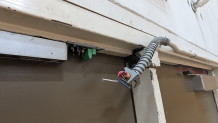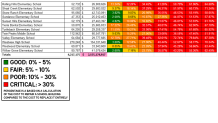The next time it rains hard in Poway, the water could wash away a $70,000 investment at Black Mountain Middle School; its newly refinished gym floor. Above that shiny surface is a roof lacking the ability to keep out the weather. Not only because it’s filled with holes but also because its six rusty air conditioning units are purely decorative.
Along with educating students, Principal Darcel Glover’s mission is to keep the 50-year-old middle school campus operating.
“You can see the wear and tear,” Glover said as he gave NBC 7 Investigates a tour of safety concerns.
Those include heavy wooden roll-out bleachers that are difficult and dangerous to move.
Get top local stories in San Diego delivered to you every morning. >Sign up for NBC San Diego's News Headlines newsletter.
“There’s thousands of pinch points within here,” Glover told us. “You can get fingers caught between these bleachers. There’s a ton of cases of serious injuries with these types of bleachers.”
We couldn’t help but notice disconnected electrical wires suspended above fire doors. Those are supposed to automatically close and lock during a fire. Needless to say, they don’t.

“Safety is like the main thing I worry about on this campus on a daily basis,” Glover said. “It’s always in the back of my mind that today is going to be the day that something happens and we’re not prepared.”
Greg Mizel, Poway Unified School District’s interim Superintendent, says it would cost $1.5 million to repair the roof and install new AC units and ductwork. The district does not have the money.
“So what we do instead is a Band-Aid approach,” Mizel told us.
But even the cost of a Band-Aid is unaffordable: The district only has $1.2 million to make facility repairs to all 40 of its campuses.
“We can’t sustain the current model," Mizel said. "It’s not sustainable.”
Less than five miles away, a broken air conditioning system at Willow Grove Elementary forced administrators to cut the school day short for three days in a row in early August. They said it was an easy choice to make when some classrooms were hitting temperatures over 80 degrees.

It wasn’t as easy on moms and dads, who had to move their schedules around to pick up their children several hours early each day.
“There definitely is something that needs to be done here,” parent Emily McDonald said. “We can’t have air conditioning going out at schools.”
Her daughters Cora and Alice were happy for the early dismissal. It meant ice cream was on the menu.
“They are sitting over there in the shade right now, but they have pink cheeks, and the same on Friday when I picked them up," McDonald said.
“At some point it’s going to impact our kids.” Mizel said. “That’s the reality. Like, right now, we’ve kept them mostly out of this, but moving forward, that’s going to be harder and harder to do.”
A district in disrepair
It’s been a year and a half since the district gave NBC 7 Investigates a similar look at its growing school facility problems.
“The problems got worse,” Mizel said. “That’s what’s happened. The problems got worse.”
In 2020, the district hired a private architecture firm to make projections on the state of its facilities and what it’s going to cost to restore schools. The consultant’s report says the district didn’t have the money to make $185 million in maintenance and repairs last year.
By 2028, Mizel says, a district of 40 campuses will have only one school rated in good condition, four schools will be rated fair, and every other campus will fall into a poor or critical rating.
A school’s condition is calculated based on the cost for the district to make repairs and replace broken equipment, compared with the total cost to replace the entire school building.


A possible solution won’t happen until 2026
Mizel said the only sustainable solution will come from Poway homeowners. While the state of California helps fund public education, it’s up to individual districts to raise money to pay for building upgrades and repairs.
The last time the district passed a bond was in 2008. That deal gave the district $105 million but required payback of nearly 10 times that amount: $981 million. The deal became the state poster child for fiscal irresponsibility, and lawmakers made those types of school bonds illegal. The district has to begin making payments on that bond in 2033. Homeowners will start seeing it included in their property tax bills in 2032-2033.
Mizel said the district needs a new bond deal and will need to convince voters to back that. He said it’s demonstrated it can spend tax dollars responsibly. Over the past seven years, Mizel said the district has refinanced its existing bonds, saving $29 million and worked to improve its credit rating.
“We’ve been fiscally prudent,” Mizel said. “We’ve done more with less.”
When NBC 7 first reported on this in 2023, district leaders said they expected to propose a new bond measure on the ballot during this 2024 presidential election. But now, 2026 is the earliest opportunity. The school district will need 55% of the vote to succeed.
This year, the board fired Superintendent Marian Kim Phelps after an investigation found she bullied high school softball players, something she denies. The scandal made national news and fractured trust in district leadership. Administrators felt any bond measure asking homeowners to trust district leadership with their money would not succeed.
“I’m not sure necessarily taxing us more is the way to go, but we need to find a solution,” McDonald said. “We can’t have our kids bear the burden of the schools’ lack of funding.”
The district will hire a consulting firm to determine exactly how much of a property tax increase they will ask voters to approve. Mizel told NBC 7 that he doesn’t want to think about what would happen to the district if a 2026 bond measure fails.
“We’re going to win in 2026,” Mizel said. “We kicked the can down the road too many times.”




